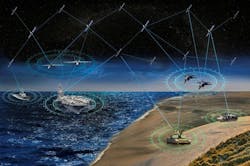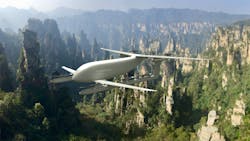In orbit: space continues to heat up for commercial and defense markets
NASHUA, N.H. - Commercial companies, military branches, and countries have their eyes on the skies - or rather, what's beyond our atmosphere here on terra firma.
The newest branch of the United States armed forces, the Space Force, notes that "Space affects almost every part of our daily lives and is fundamental to our economic system. For example, satellites not only power the GPS technology that we use daily, but allow us to surf the web and call our friends, enable first responders to communicate with each other in times of crisis, time-stamp transactions in the world financial market, and even allow us to use credit cards at gas pumps."
Earlier this month, the Boeing Market Outlook was announced by the aerospace giant, and in a combined forecast, the Chicago company projects the defense and space market opportunity will remain consistent with last year's forecast at $2.6 trillion during the next decade. These large, stable markets have enduring demand driven by geopolitical and security challenges. This spending projection continues to reflect the ongoing importance of military aircraft, autonomous systems, satellites, spacecraft and other products for national and international defense, with 40 percent of expenditures expected to originate outside of the United States.
"While we've seen resiliency and stability in the global defense and space market, the threat environment continues to evolve," said Leanne Caret, president and CEO of Boeing Defense, Space & Security. "Winning the future fight will require speed and flexibility, and Boeing is committed to designing, testing, building and sustaining in a way that will enable our customers to adapt at the speed of relevance and derive the most value from our platforms for decades to come. Our mission – which is grounded in safety, quality and integrity – is to deliver the most digitally advanced, simply and efficiently produced solutions that are intelligently supported to our global customers."
Think small
In August, Honeywell announced that Pipistrel had selected its compact SATCOM system for its unmanned aerial vehicle (UAV) Nuuva platforms.
Weighing in at only 1 kilogram (2.2 pounds), Honeywell’s Small UAV SATCOM system is 90% lighter than the company’s next smallest connectivity system, yet itHoneywell also announced that the company was adding a trio of offerings to its space offerings for the smallsat market.
The newest additions include Honeywell’s X Band Downlink Transmitter and Optical Communication Terminal (OCT), which enable high-bandwidth data to be transmitted both down to Earth and between satellites. Additionally, Honeywell is debuting a new line of Commercial Series reaction wheel assemblies specifically designed for commercial space satellites.
All three of these new products are intended to serve the small commercial satellite market segment, which has cost and production volume requirements different than traditional space programs. Instead of producing only one satellite that must function for years or decades, these satellites are smaller, have a shorter lifespan, and are often part of a large network composed of dozens or hundreds of satellites, known as a “constellation.”
Though they can perform a variety of tasks, two common uses for satellites are to capture images of Earth and to enable connectivity, or internet service. Honeywell’s new X Band Downlink Transmitter and OCT are designed to handle large amounts of data being transmitted from and between satellites.
In other smallsat news, moves are being made to bring a launch site to the United Kingdom. The Space Hub Sutherland could allow smallsats to be launched from the U.K. for the first time.
Highlands and Islands Enterprise is developing the Space Hub Sutherland project, which is the first vertical launch site to secure planning permission in the U.K. The site is slated to host the Scottish-manufactured Orbex Prime low-carbon fuel rocket and could begin launching low-earth orbit communication and observation satellites as early as next year from a site on the Mhòine Peninsula.
"Our research, economic modeling and strategy planning will identify what needs to be done to create a space cluster of specialized industries in northern Scotland, supported by supply chain, local skills and talent, and infrastructure capable of sustaining its growth," said Jacobs Critical Mission Solutions International Senior Vice President Clive White. "With estimates that the U.K.'s space industry will be worth $5.6 billion (£4 billion) by 2030, this is a huge opportunity for the area with potential to create many high-value jobs. During this project, we will leverage our teams supporting NASA, where Jacobs is the largest services provider."
Eyes on defense
The Defense Advanced Research Projects Agency (DARPA) Blackjack program has awarded Northrop Grumman Corporation a contract for Phase 2 development of an advanced, software-defined positioning, navigation and timing (PNT) payload, with options to build units destined for space flight.
The PNT payload work is led by Northrop Grumman’s Future PNT Systems Operating Unit in Woodland Hills. The team supports the DARPA Tactical Technology Office’s goal of achieving capable, resilient and affordable national security space capabilities from low Earth orbit (LEO).
"Northrop Grumman’s software-defined Positioning, Navigation and Timing technology will offer military users an agile new signal from LEO that is not dependent on existing satellite navigation systems," said Dr. Nicholas Paraskevopoulos, chief technology officer and sector vice president, emerging capabilities development, Northrop Grumman. "Warfighters depend on assured PNT for traditional missions like force projection and joint operations, but also for emerging autonomous and distributed missions."

